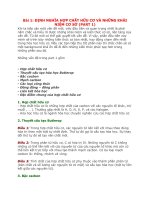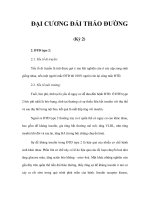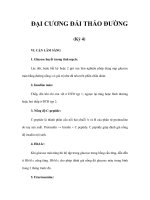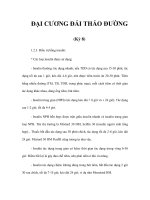Đại cương về lãnh đạo trong tổ chức chapter 11 strategic leadership
Bạn đang xem bản rút gọn của tài liệu. Xem và tải ngay bản đầy đủ của tài liệu tại đây (309.66 KB, 36 trang )
.c
om
an
co
ng
Chapter 11
cu
u
du
o
ng
th
Strategic Leadership
and Change Management
Copyright © 2010 by South-Western/Cengage Learning
All rights reserved.
CuuDuongThanCong.com
PowerPoint Presentation by Rhonda S. Palladi
Georgia State University
/>
.c
om
Strategic Leadership
cu
u
du
o
ng
th
an
co
ng
Is a person’s ability to anticipate, envision,
maintain flexibility, think strategically, and work
with others to initiate changes that will create a
viable future for the organization
Is a process of providing the direction and
inspiration necessary to create and implement a
firm’s vision, mission, and strategies to achieve
organizational objectives
Must involve managers at the top, middle, and
lower levels of the organization
2
CuuDuongThanCong.com
/>
.c
om
Strategic Leadership (cont.)
Effective strategic leaders are skilled at:
cu
u
du
o
ng
th
an
co
ng
Anticipating and forecasting events in the external
environment that have the potential to impact
business performance
Finding and sustaining competitive advantage by
building core competencies and selecting the right
markets in which to compete
Evaluating strategy implementation and results
systematically, and making strategic adjustments
Building a highly effective, efficient, and motivated
team of employees
Deciding on appropriate goals and priorities for
achieving them
Being an effective communicator
CuuDuongThanCong.com
/>
3
.c
om
Strategic Leadership Failures
cu
u
du
o
ng
th
an
co
ng
When the strategic vision for the
organization favors the senior executive’s
personal interests and not enough of
their constituents’ and organization’s
interests
When senior executives use failure-prone
practices
When senior executives engage in or
condone unethical conduct
4
CuuDuongThanCong.com
/>
.c
om
Strategic Leadership Failures (cont.)
cu
u
du
o
ng
th
an
co
ng
When senior executives pay little or no
attention to productivity, quality, and
innovation
When senior executives allocate time and
money unwisely
When senior executives use too much
intuition and too little rational analysis
5
CuuDuongThanCong.com
/>
.c
om
Strategic Management
ng
Effective strategists are said to perform
four primary responsibilities:
cu
u
du
o
ng
th
an
co
Conceptualize the organization’s vision,
mission, and core values
Oversee the formulation of objectives,
strategies, policies, and structures that
translate vision, mission, and core values
into business decisions
Create an environment and culture for
organizational learning and mutual exchange
between individuals and groups
Serve as steward and role model for the rest 6
CuuDuongThanCong.com
/>
.c
om
Strategic Management (cont.)
cu
u
du
o
ng
th
an
co
ng
Is the set of decisions and actions used to
formulate and implement specific strategies that
will achieve a competitively superior fit between
the organization and its environment, so as to
achieve organizational goals
A basic distinction between strategic leadership
and strategic management is that strategic
Leadership envisions where the organization
would like to be in five to ten years while
strategic management focuses on how to
achieve the vision
7
CuuDuongThanCong.com
/>
.c
om
Strategic Management Framework
Analyze external
environment
co
ng
Analyze internal
environment
an
Vision/Mission
Feedback
Implement Strategy
u
du
o
Formulate Strategy
cu
Feedback
ng
th
Strategic Goals
Evaluate Strategy
Strategic Competitiveness
and Above-Average Returns
CuuDuongThanCong.com
/>
8
.c
om
The Strategic Management Process
cu
u
du
o
ng
th
an
co
ng
The strategic management process
begins with the strategist’s vision
Next, long-term or corporate goals define
specific outcomes that an organization
seeks to achieve in order to realize its
mission
Strategy formulation specifies the
strategies for achieving an organization’s
objectives
9
CuuDuongThanCong.com
/>
.c
om
The Strategic Management
Process (cont.)
cu
u
du
o
ng
th
an
co
ng
Strategy implementation takes place
through the basic organizational
architecture that makes things happen
The final phase, strategy evaluation,
involves comparing expected outcomes
with actual results after the
implementation phase
10
CuuDuongThanCong.com
/>
.c
om
The Strategic Management
Process (cont.)
Analyzing the environment
th
an
co
ng
Involves being able to identify and interpret
emerging trends before they become evident
to everyone else
It is essential to learn and understand:
cu
u
du
o
ng
– The concerns of customers
– The availability and bargaining power of suppliers
and customers
– The actions of competitors
– Market trends
– Economic conditions
– Government policies
– Technological advances
CuuDuongThanCong.com
/>
11
.c
om
The Strategic Management
Process (cont.)
Analyzing the environment (cont.)
u
du
o
Market strength
Financial position
Capabilities
Core competencies
Culture
Structure
cu
–
–
–
–
–
–
ng
th
an
co
ng
Knowing what competitors are doing and
how to respond is clearly important to a
firm’s survival
Analyzing the internal environment focuses
on assessing an organization’s:
12
CuuDuongThanCong.com
/>
.c
om
The Strategic Management
Process (cont.)
Analyzing the environment (cont.)
cu
u
du
o
ng
th
an
co
ng
The combined analysis of the external
environment and internal environment is
commonly referred to as SWOT (Strengths,
Weaknesses, Opportunities, and Threats), or
situation, analysis
Accurate interpretation of both types of
environments requires considerable
analytical and cognitive skills, and plays a
large part in the future actions and the
continuing effectiveness of an organization
13
CuuDuongThanCong.com
/>
.c
om
The Strategic Management
Process (cont.)
Vision statement
u
du
o
Facilitates decision making
Inspires followers
Links the present to the past
Gives meaning to work, not just what, but why
Establishes a standard of excellence
Lays the foundation for the development of a mission
statement
cu
–
–
–
–
–
–
ng
th
an
co
ng
Is an ambitious view of the future that everyone in the
organization can believe in and that is not readily
attainable, yet offers a future that is better in
important ways than what now exists
A clear and inspiring vision serves a number of
important functions:
14
CuuDuongThanCong.com
/>
.c
om
The Strategic Management
Process (cont.)
Mission statement
du
o
ng
th
an
co
ng
Is an enduring statement of purpose that
distinguishes one organization from other
similar enterprises
Is the organization’s core purpose and
reasons for existence
Features two components:
cu
u
– Core values
– Core purpose
15
CuuDuongThanCong.com
/>
.c
om
The Strategic Management
Process (cont.)
Mission statement (cont.)
u
du
o
ng
th
Providing direction and focus
Forming the basis for objectives and strategies
Inspiring positive emotions about the organization
Ensuring unanimity of purpose
Helping resolve divergent views among employees
cu
–
–
–
–
–
an
co
ng
Should be both broad and specific
Can provide many benefits to an
organization:
16
CuuDuongThanCong.com
/>
.c
om
The Strategic Management
Process (cont.)
Corporate-level goals
cu
u
du
o
ng
th
an
co
ng
Are the desired long-term outcomes that an
organization seeks to achieve for its various
stakeholders
Include both financial and strategic goals
Are essential because they help focus
everyone in the same direction
Are the targets against which actual
performance is compared for strategy
evaluation
Create synergy
17
CuuDuongThanCong.com
/>
.c
om
The Strategic Management
Process (cont.)
Corporate-level goals (cont.)
u
Specific
Measurable
Achievable
Results-Based
Time-Specific
cu
–
–
–
–
–
du
o
ng
th
an
co
ng
Are the means by which organizations reveal
their priorities
Are the basis for effective planning,
organizing, leading, and controlling activities
Organizations must take time to establish
“SMART” goals
CuuDuongThanCong.com
18
/>
.c
om
The Strategic Management
Process (cont.)
Strategy formulation
cu
u
du
o
ng
th
an
co
ng
A strategy is an integrated, overarching plan
of how an organization will achieve its
objectives
A good strategy focuses on exploiting
opportunities in the organization’s external
environment that match the organization’s
strengths.
A good strategy must also reflect the core
mission and objectives of the organization
19
CuuDuongThanCong.com
/>
.c
om
The Strategic Management
Process (cont.)
Strategy formulation (cont.)
co
ng
To maintain a competitive edge over rivals,
develop strategies that:
an
– Enhance value to the customers
ng
th
Value is the ratio of benefits received to the cost
incurred by the customer
du
o
– Create synergistic opportunities
– Build on the company’s core competence
cu
u
A core competence is a capability that allows an
organization to perform extremely well in
comparison to competitors
20
CuuDuongThanCong.com
/>
.c
om
The Strategic Management
Process (cont.)
Strategy formulation (cont.)
ng
th
an
Are rare
Are hard to imitate
Are not easily substitutable
Create value for the firm
du
o
–
–
–
–
co
ng
Core competencies are a source of
competitive advantage when they:
cu
u
A knowledge-based competitive advantage is
hard to imitate or copy by rivals because it
resides in people, not physical assets
Core competencies increase as they are used
to gain a competitive advantage over rivals
21
CuuDuongThanCong.com
/>
.c
om
The Strategic Management
Process (cont.)
Strategy implementation
cu
u
du
o
ng
th
an
co
ng
Effective strategy implementation means
that objectives have a greater chance of
being met and thus results in better firm
performance
Requires galvanizing the organization’s
employees and managers at all levels to turn
formulated strategies into action
Obstacles to effective strategy
implementation
– Lack of resources
– Time
CuuDuongThanCong.com
22
/>
.c
om
The Strategic Management
Process (cont.)
Strategy implementation (cont.)
co
ng
Is considered the most difficult stage of the
strategic management process
ng
th
an
– Involves dealing with people who come with
varying levels of motivation, commitment, and
dedication
du
o
Without appropriate implementation, the
best of strategies can fail
cu
u
– Must be integrated into all organizational systems
including structure, culture, pay and reward
systems, budget allocation, and organizational
rules, policies, and procedures
23
CuuDuongThanCong.com
/>
.c
om
The Strategic Management
Process (cont.)
Strategy evaluation
co
ng
Is the primary means of determining the effectiveness
of the strategic management process
Has three fundamental activities:
ng
th
an
– Review internal and external factors
– Measure performance against objectives
– Corrective action
du
o
A popular tool used to measure the effectiveness of the
strategic management process is the balance scorecard
cu
u
– Translates mission and vision statements into a
comprehensive set of objectives and performance
measures that can be quantified and appraised
24
CuuDuongThanCong.com
/>
.c
om
Implementing Change
cu
u
du
o
ng
th
an
co
ng
Organizational change is an alteration in
an organization’s alignment with its
external environment
Organizations spend millions of dollars
on change efforts
Change can be transformational or
incremental
Organizational change is any transition
that requires a change in human
performance
25
CuuDuongThanCong.com
/>









